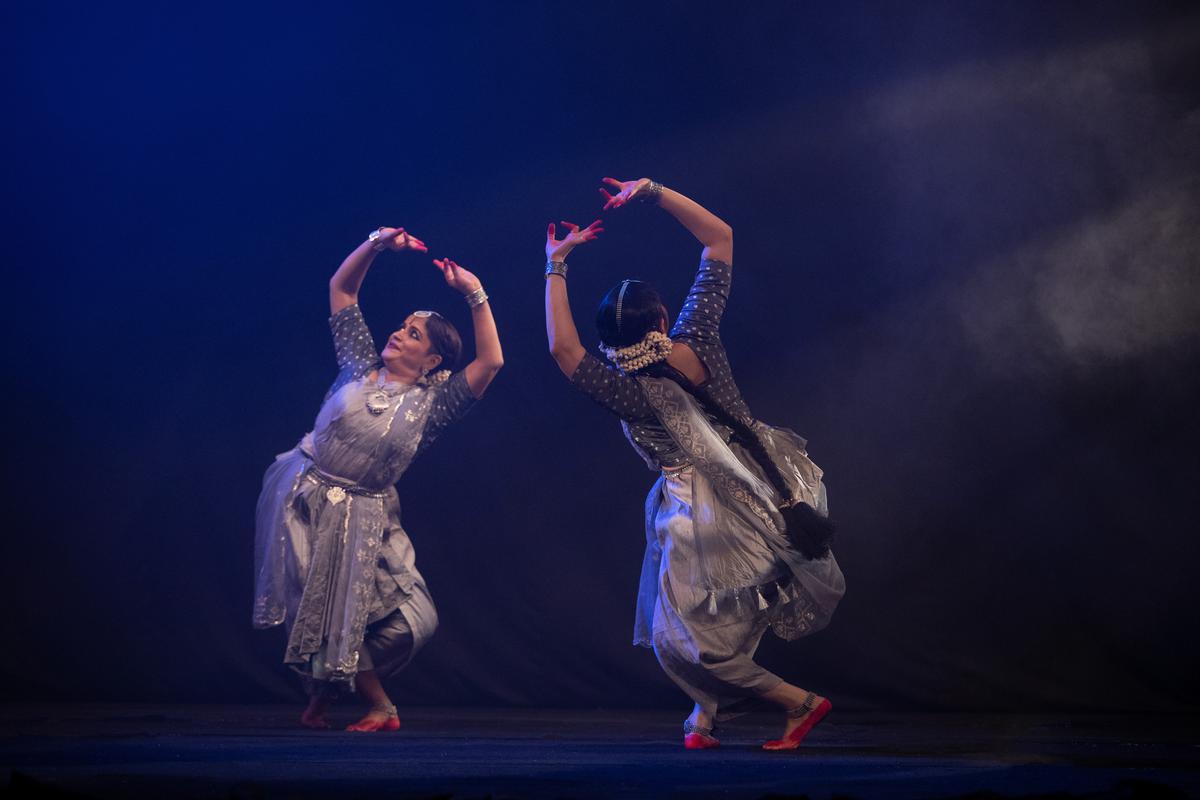Indira Kadambi’s latest choreography, Koham, spelt sophistication from start to finish. It integrated highest spiritual thought with the mundane through well-designed music and a tight movement script.
A bold concept, the production was put forth by Indira and her senior student Meera Sreenarayanan based on the abstract Mahavakyams from the Upanishads for the Natyavamsham series. These online programmes curated by Rama Vaidyanathan, focus on the guru-sishya synergies and are presented by the GVRNK Foundation to celebrate 10 years of its annual festival, ‘Margazhi’, in Mumbai.
In Advaita Vedanta, there is a Neti Neti concept that negates all that is unreal — the body, the mind, the senses, the world etc. The subsequent question is usually ‘Koham’, (then) who am I? This was a challenging concept for a visual art form. With the help of clear thinking and enough experts — voice overs (Praveen D. Rao), a melodious, tailored musical score (T.V. Ramprasadh, Praveen D.Rao), evocative lighting and camera work (Jose Koshi, Prajeesh Bhaskar) and editing (Tanvy Shah, Meera), they explained the concept through the three states of consciousness — Jagrat (awakened), Svapna (dream) and Sushupti (deep sleep), rephrasing them as The Dance of Bodies, The Dance of Minds and The Dance of Consciousness.

From ‘Koham’
| Photo Credit: Special Arrangement
The Dance of the Bodies (Indira, Apeksha Kamath) dealt with the beginning of creation. Silence was filled with the recitation of the Maheshwara sutras, as the entwined causal body disengages and forms the five elements, picturised with mime and aerial shots of the shape that the element carries. As the creation evolved, so did the music. From syllables, it moved to swaras and into a melody (Karaharapriya, the first raga in Carnatic music) as pancha bhoothas evolved into animals and specifically into homo sapiens, with Indira miming the evolution of the two-legged man.
The dancers enjoyed movement, and they broke into nadai-based steps in a Mohanam jatiswaram. The questioning begins — ‘I am dancing, but what is dance? What is the purpose of my dance? … He is the purpose, He is the action…the dance…’
Lilting jathis
The ‘He’, Shiva, was introduced in the Thodi padavarnam, ‘Adi Shivanaik kaanave asai kondenadi’ (Dhandayuthapani Pillai, Adi) where the heroine is yearning to see Shiva. The lilting Dhandayuthapani jathis rendered by the calm baritone (Praveen Kumar) was as melodious as the music.
Having established the God, the search continued. Is he the eternal supreme being? Is he the dance? The guru walks away leaving the sishya to her thoughts.
Heroines in three emotional states in well-known padams were taken up in the Dance of the Minds (Indira, Meera). They enacted them in their dreams. ‘Choodare’ (Kshetragna, Sahana) had the dancers condemning a woman for being reckless in her love for Krishna. Meera woke up asking, ‘Is that woman me?’ Indira’s desolation in Kshetragna’s ‘Payyada’ (Nadanamakriya) brought the depth of her abhinaya. Seamlessly, she turned into Krishna in Jayadeva’s ‘Prathama samagana’ who seduces the guileless Radha (Meera) while talking sweet words to her. Meera wakes up with more questions , ‘Was that a dream? I felt I was Radha. What is real?’
The Dance of Consciousness (Indira, Meera) had the dancers weaving in and out of shadows, as they performed the Raas Kreeda to the title track. They moved up and down the central fulcrum as they merged as one. A voice-over said, ‘I am not the mind, ego, intellect or memory, I am not the experience or the experiencer…’
A well-integrated effort with excellent standard of Bharatanatyam. Importantly, it made sense.
The Chennai-based reviewer specialises in classical dance.
For all the latest Entertainment News Click Here
For the latest news and updates, follow us on Google News.
